Unsure about your French table manners? Click Here to download > > How to avoid these 10 food etiquette mistakes !
- Home ›
- Destinations ›
- Southern France ›
- Escoffier Museum
The Escoffier Museum: An Ode to the Master Chef
Published 27 July 2025 by Leyla Alyanak — Parisian by birth, Lyonnaise by adoption, historian by passion
In a quiet backstreet of Villeneuve-Loubet, just inland from the Riviera, you'll find the house where Auguste Escoffier was born. Today it’s a small, unassuming museum that tells the story of the man who helped turn cooking into a high-status profession.
On a recent trip to the Côte d'Azur, I did something I'd wanted to do for a while: pay homage to Auguste Escoffier, that behemoth of French gastronomy.
Tucked away on a small, hilly street in the old part of Villeneuve-Loubet, a coastal resort between Nice and Cannes, is the house in which he was born in 1846.
Today, it is a museum that houses his body of work, but it still feels domestic, like a home, with low ceilings and warm stone walls. One room even smells of chocolate, a reminder of why it is we're visiting in the first place. Guided tours are on offer if you're keen to deepen your knowledge of French culinary history.
Who exactly was Chef Auguste Escoffier?
Every professional French chef knows the name of the man who more or less invented the kitchen brigade. So do thousands who love good food and are interested in the history of French gastronomy...
So here goes: you could say Georges Auguste Escoffier was a French culinary giant whose genius straddled two centuries, and who put French cuisine on the map. He is also widely regarded as one of the fathers of modern French cuisine, although this being France, there will always be some sort of argument about who was best, or first (see the blue box below).

If you've ever eaten from a fixed-price menu, admired the precision of a restaurant kitchen, or watched a chef in a starched white toque command a brigade of cooks, you're seeing something created by Escoffier.
He wanted to be a sculptor but his father placed him as an apprentice in a restaurant. He began cooking at age 12, and his career was launched.
Escoffier was famously known as “the king of chefs and the chef of kings” (le roi des cuisiniers et le cuisinier des rois). The title may have been bestowed by Kaiser Wilhelm II of Germany, impressed by Escoffier’s culinary prowess during a royal banquet.
His rapid rise was interrupted by the Franco-Prussian War, but it wasn't time wasted. He headed several army kitchens, and learned preservation techniques as well as how to use every last bit of food.
Escoffier met César Ritz in 1884 at the Grand Hôtel in Monte-Carlo, where Ritz was manager and Escoffier head chef; together, they pioneered a new model of grand luxury hospitality. Rail travel encouraged the opening of huged luxury hotels whose dining rooms redefined fine cuisine and became a fashionable space, even for women.
Escoffier would rise through the ranks to become chef at the Savoy Hotel in London, and later the Ritz in Paris (not without a few scandals, which I'll tell you about in a moment). There, he served monarchs, magnates and opera stars, shaping the grand dining style of the Belle Époque.
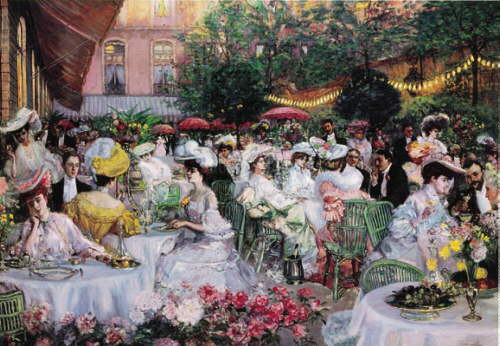 Ritz Paris Garden, a painting by Pierre-Georges Jeanniot, 1904. This is the era over which Escoffier and Ritz reigned
Ritz Paris Garden, a painting by Pierre-Georges Jeanniot, 1904. This is the era over which Escoffier and Ritz reignedWHO WAS THE REAL FATHER OF FRENCH CUISINE?
Of course there's Escoffier, to whom this article is dedicated. But there are other contenders...
Marie-Antoine Carême (1784–1833)
He was perhaps the first true celebrity chef, and elevated cooking to a high art under Napoleon (what a waste - Napoleon wasn't particular to food...) He designed elaborate food sculptures (pièces montées) and codified the early "mother sauces". He also wrote some of the first encyclopedic cookbooks. His cuisine was extravagant - Escoffier would simplify it.
Fernand Point (1897–1955)
He can claim to having trained some of the 20th century's legendary chefs, including Paul Bocuse and the Troisgros brothers. His restaurant, La Pyramide in Vienne, was famous for its elegance and precision and emphasized seasonal ingredients and lighter sauces. He helped lighten Escoffier's formality.
Paul Bocuse (1926–2018)
He was the public face of nouvelle cuisine, which you may love or detest. He promoter a lighter and more modern take on French food, and became a media personality, helping elevate the profession to stardom. He helped French cuisine move into the television era, and turned it into an international aspiration.
What's cooking inside the museum?
The Escoffier Museum of Culinary Arts – the Musée Escoffier de l'Art Culinaire – is a small museum, only eight rooms, but each walks you through a different facet of Escoffier's world.
When you first walk in, it feels like a house. The tiled floors are a little uneven, and you almost expect a bird or two to land on the windowsill.
You’ll pass through a reconstructed 19th-century kitchen, complete with traditional stove and gleaming copper pans. In another room, copper utensils line the walls.
Further in, you’ll find the Salon d’Auguste, his personal living room recreated with period furnishings, and a small library of more than 3000 culinary works, including rare historical cookbooks.
Possibly one of my favorite rooms is the one dedicated to pastry, filled with delicate sugar and chocolate sculptures from which a distinct smell of cocoa rises. Believe me, you'll know it with your eyes closed.
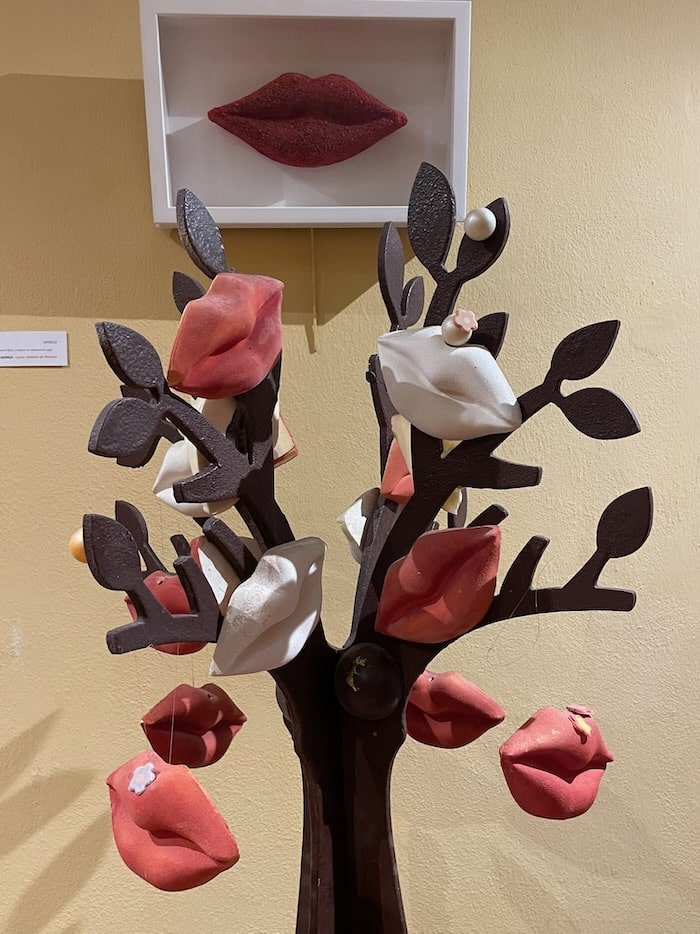 From the patisserie room
From the patisserie roomIn other rooms, you’ll find menus from royal banquets (including the coronation of King Edward VII), early editions of his famed Guide Culinaire, photographs of the chefs he trained, even letters and medals.
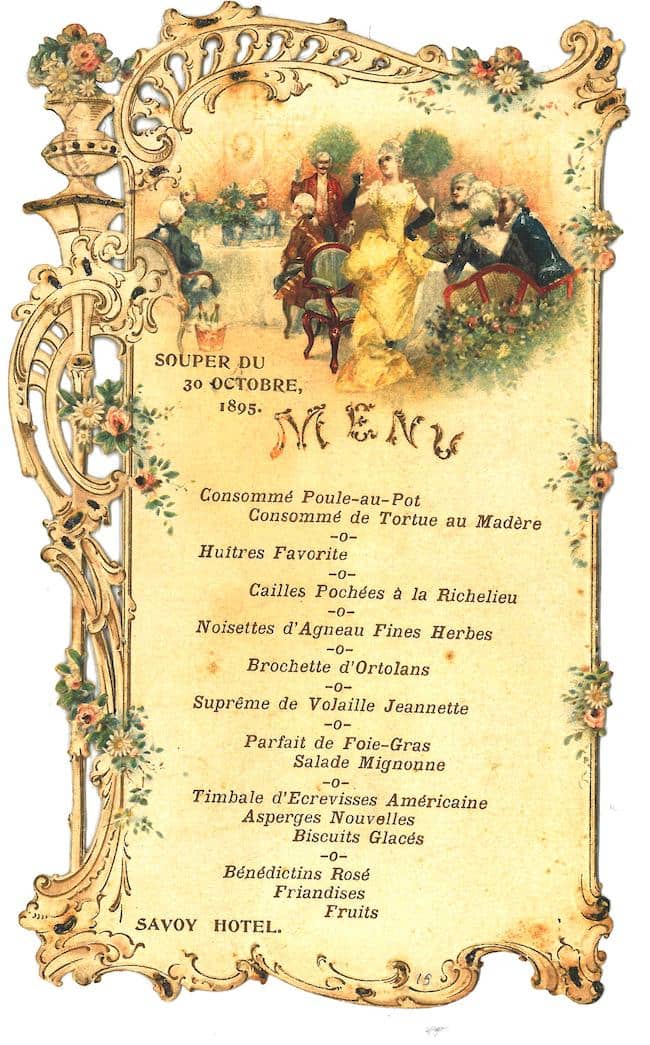
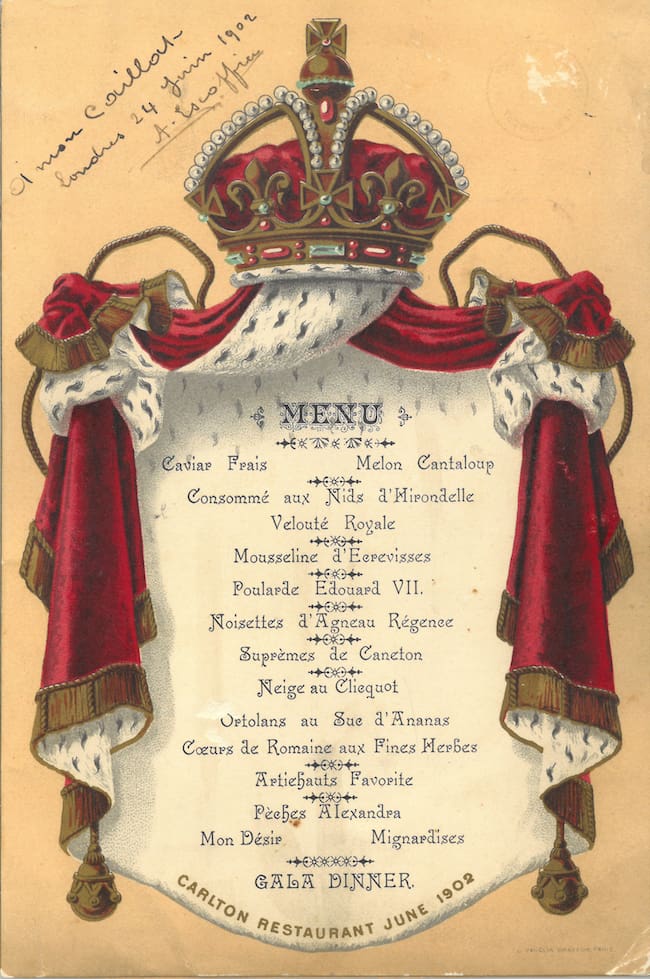
In 2010, the museum was awarded the "Maison des Illustres" label of excellence, awarded by the Ministry of Culture to the preserved homes of illustrious Frenchmen and women.
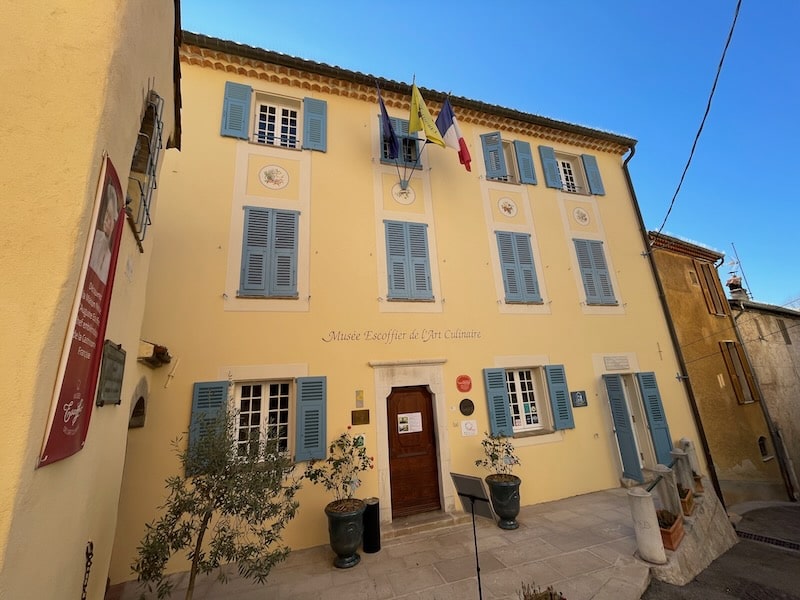
NOTE ➠ The museum is located in Villeneuve-Loubet Village, which is not the same as the modern beach area (plage) of the same name, right next to it. Look at a map or you might end up driving in circles around a giant parking lot, as I did. Reaching the museum is easiest by car but there are plenty of buses from Nice (#650 towards Grasse) and Cannes.
How Escoffier changed the kitchen forever
It's one thing to be a great chef – it's another to revolutionize an entire profession. Yet that's what Escoffier did:
- he eliminated chaos in the kitchen and simplified what happened there
- he created (or certainly institutionalized) the brigade system, assigning each sub-chef a distinct role
- he modernized menus and standardized recipes so dishes would taste the same each time they were served
- he banned smoking and drinking in the kitchen and formalized the chef's uniform, including the white toque
- he emphasized seasonal ingredients
- he elevated the chef’s status from tradesman to artist.
For now, this will do, although he did plenty more. Under Escoffier, the kitchen became a professional workplace and its workers worthy of respect.
A few offbeat facts about Escoffier
We are aware of his prowess and innovation, but there are other sides to this culinary genius.
He fought waste
Long before it was fashionable, Escoffier was conscious of food waste. Perhaps because of his humble origins or experiences cooking in the army, Escoffier demonstrated extraordinary management skills, storing for a rainy day and making sure he had alternatives for whatever goods might be scarce, like salt or sugar.
He invented dishes
You're probably familiar with Peach Melba, the dessert (peaches, raspberry sauce and vanilla ice cream) he created for the Australian soprano Nellie Melba.
He also created another peach dessert, Peach Mistral, in honor of the famous Provençal poet and Nobel Prize winner Frédéric Mistral. In this recipe, white peeled peaches are lightly powdered with sugar and covered in a strawberry purée, all of it smothered in vanilla-flavored whipped cream. Hungry yet?
He may also be responsible (none of this is proven) for Sarah Bernhardt strawberries (involving pineapple and Curaçao sherbet), Réjane Salad (Gabrielle Réjane was a French actress of the period) and even Tournedos Rossini, in honor of the Italian composer. All in all, he is credited with having created some 5000 recipes.
He had a strong social conscience
In 1910, he published the Projet d’assistance mutuelle pour l’éradication du paupérisme, a forward-thinking plan to finance pensions by replicating the army’s mutual-assistance model.
His plan included pooling deposits at the birth of each child to build a community fund, using taxes to finance a government reserve fund, and even a solidarity lottery and local charity festivals.
His goal was to build a social safety net that could eliminate poverty and end street begging. He also lobbied for universal retirement, years before the creation of modern welfare systems.
Much more than a simple chef...
 Escoffier's office
Escoffier's office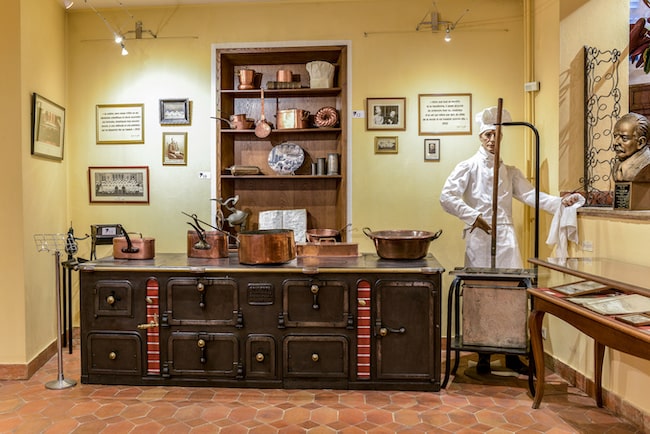
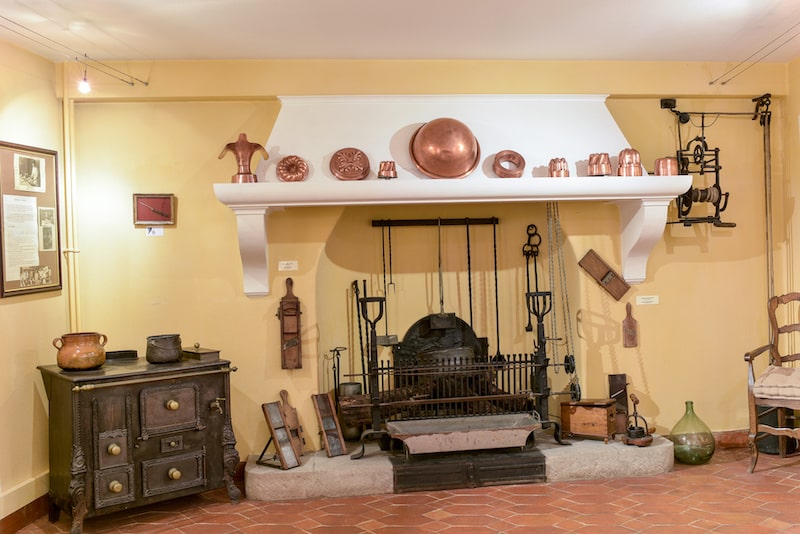 The kitchen
The kitchenScandal in the kitchen
Auguste Escoffier might have been a stickler for order, but working with society's luminaries left a bit of a mark.
In 1898, he and César Ritz were abruptly dismissed from the Savoy Hotel in London on charges of financial misconduct, including accepting kickbacks from suppliers and diverting luxury goods. These allegations never made it to trial, but the dismissals were public and damaging
Within two years, the two men had opened the Ritz Paris, followed by the Carlton in London. Far from ruining them, the scandal seemed to have burnished their stars. If you were anyone in society and seeking luxury, you wanted to hobnob with Escoffier and Ritz.
The Ritz became the dining room of those whose characters might not be completely above reproach – scandal-ridden financiers, exiled monarchs, colonial profiteers, and all their mistresses. Those embroiled in other scandals of the time (the Panama Canal scandal or the Baccarat Affair) found their way to the Ritz dining room.
You may not find much about this side of Escoffier's character in the museum, which strives to show off his artistry and legacy. But no matter. He innovated so much that when it comes to French cuisine, a whiff of scandal certainly did him little harm.

Before you go...
Thanks to Escoffier, and long before Michelin stars or Top Chef were a thing, being a chef became a status symbol. It was, however, a symbol that was exclusively male.
Women may have ruled the domestic kitchen, but when it came to the public accolades, they were nowhere to be seen. Read about how this is changing in my Substack post entitled "The Chef and the Cook: Gender, Power, and the French Kitchen."
FAQ
What is Escoffier most famously known for?
What is Escoffier most famously known for?
Escoffier is most famously known for revolutionizing French cuisine by introducing the brigade system, codifying recipes, and elevating the status of the professional chef.
What type of food is Auguste Escoffier known for?
What type of food is Auguste Escoffier known for?
Auguste Escoffier is known for refined, classical French cuisine, emphasizing structured menus, elegant presentation, and rich, elaborate sauces.
What happened to Auguste Escoffier?
What happened to Auguste Escoffier?
Auguste Escoffier enjoyed a long and celebrated career as a chef, author, and culinary reformer; despite a scandal that led to his dismissal from the Savoy Hotel in 1898, he continued to shape haute cuisine through his partnership with César Ritz and retired with widespread acclaim, passing away peacefully in 1935 at the age of 88.
Did Auguste Escoffier own any restaurants?
Did Auguste Escoffier own any restaurants?
Auguste Escoffier did not own restaurants himself; instead, he worked as head chef in prestigious hotels like the Savoy in London and the Ritz in Paris, where he created legendary menus and helped define the luxury dining experience.
Did you enjoy this article? I'd love if you shared it!

